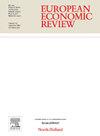自动化和仆人经济的兴衰
IF 2.4
2区 经济学
Q1 ECONOMICS
引用次数: 0
摘要
我们发展了一种宏观经济理论,研究家务在仆人和自己的工作之间的分工,以及它如何受到家庭和企业自动化的影响。我们对模型进行了校正,并应用它来解释1900年至2020年家庭时间使用和家庭任务分配的历史发展。经济由高技能和低技能的家庭组成,家务由自己的工作、机器或仆人完成。在1900-1960年期间,家庭自动化的创新促使仆人经济的衰落,新的家务任务的创造促使家庭时间在工资工作和家务劳动之间几乎不变地分配。在1960-2020年期间,企业自动化的创新和隐含的技能溢价的增加解释了仆人经济的回归。我们使用反事实的历史实验来评估自动化的作用、新家务的创造以及零工经济对家庭时间和任务分配的影响。我们为自动化与不平等之间的关系,以及不平等作为2005-2020年期间美国大都市统计区区域面板中仆人经济回归的驱动因素提供了支持性证据。本文章由计算机程序翻译,如有差异,请以英文原文为准。
Automation and the fall and rise of the servant economy
We develop a macroeconomic theory of the division of household tasks between servants and own work and how it is affected by automation in households and firms. We calibrate the model for the U.S. and apply it to explain the historical development of household time use and the distribution of household tasks from 1900 to 2020. The economy is populated by high-skilled and low-skilled households and household tasks are performed by own work, machines, or servants. For the period 1900–1960, innovations in household automation motivate the decline of the servant economy and the creation of new household tasks motivates an almost constant division of household time between wage work and domestic work. For the period 1960–2020, innovations in firm automation and the implied increase of the skill premium explain the return of the servant economy. We use counterfactual historical experiments to assess the role of automation, the creation of new household tasks, and the gig economy for the division of household time and tasks. We provide supporting evidence for the relation between automation and inequality, and for inequality as a driver of the return of the servant economy in a regional panel of U.S. metropolitan statistical areas for the period 2005–2020.
求助全文
通过发布文献求助,成功后即可免费获取论文全文。
去求助
来源期刊

European Economic Review
ECONOMICS-
CiteScore
4.70
自引率
3.60%
发文量
170
期刊介绍:
The European Economic Review (EER) started publishing in 1969 as the first research journal specifically aiming to contribute to the development and application of economics as a science in Europe. As a broad-based professional and international journal, the EER welcomes submissions of applied and theoretical research papers in all fields of economics. The aim of the EER is to contribute to the development of the science of economics and its applications, as well as to improve communication between academic researchers, teachers and policy makers across the European continent and beyond.
 求助内容:
求助内容: 应助结果提醒方式:
应助结果提醒方式:


